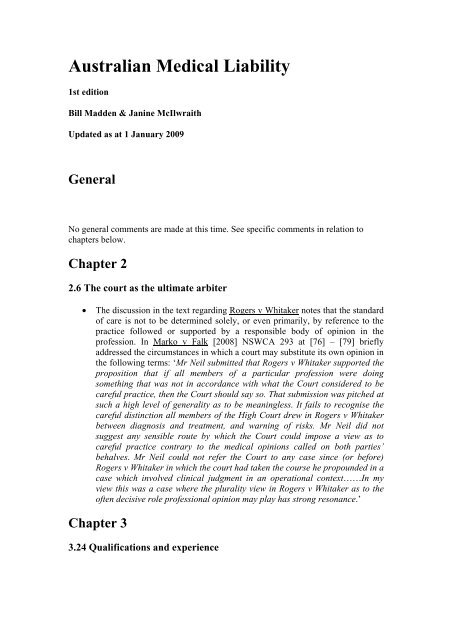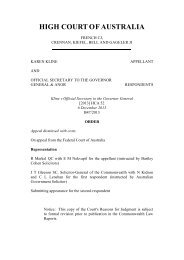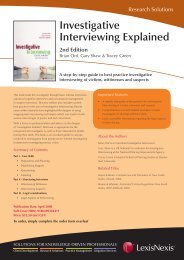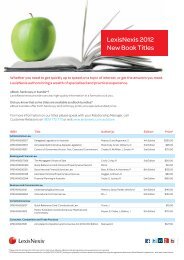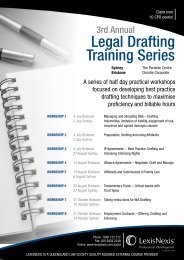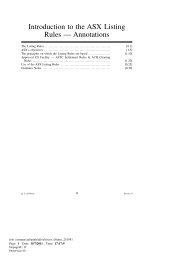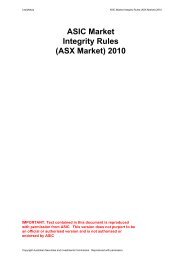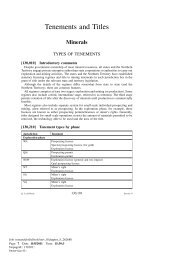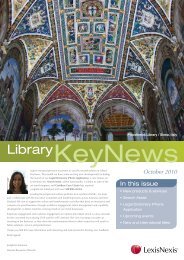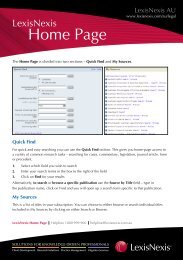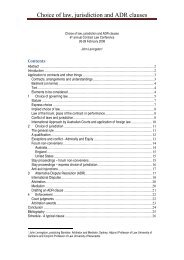Chapter 2 - LexisNexis
Chapter 2 - LexisNexis
Chapter 2 - LexisNexis
Create successful ePaper yourself
Turn your PDF publications into a flip-book with our unique Google optimized e-Paper software.
Australian Medical Liability<br />
1st edition<br />
Bill Madden & Janine McIlwraith<br />
Updated as at 1 January 2009<br />
General<br />
No general comments are made at this time. See specific comments in relation to<br />
chapters below.<br />
<strong>Chapter</strong> 2<br />
2.6 The court as the ultimate arbiter<br />
• The discussion in the text regarding Rogers v Whitaker notes that the standard<br />
of care is not to be determined solely, or even primarily, by reference to the<br />
practice followed or supported by a responsible body of opinion in the<br />
profession. In Marko v Falk [2008] NSWCA 293 at [76] – [79] briefly<br />
addressed the circumstances in which a court may substitute its own opinion in<br />
the following terms: ‘Mr Neil submitted that Rogers v Whitaker supported the<br />
proposition that if all members of a particular profession were doing<br />
something that was not in accordance with what the Court considered to be<br />
careful practice, then the Court should say so. That submission was pitched at<br />
such a high level of generality as to be meaningless. It fails to recognise the<br />
careful distinction all members of the High Court drew in Rogers v Whitaker<br />
between diagnosis and treatment, and warning of risks. Mr Neil did not<br />
suggest any sensible route by which the Court could impose a view as to<br />
careful practice contrary to the medical opinions called on both parties’<br />
behalves. Mr Neil could not refer the Court to any case since (or before)<br />
Rogers v Whitaker in which the court had taken the course he propounded in a<br />
case which involved clinical judgment in an operational context……In my<br />
view this was a case where the plurality view in Rogers v Whitaker as to the<br />
often decisive role professional opinion may play has strong resonance.’<br />
<strong>Chapter</strong> 3<br />
3.24 Qualifications and experience
• Imbree v McNeilly [2008] HCA 4. Consideration of aspects of Cook v Cook;<br />
Duty of care in the context of special relationship between plaintiff and<br />
defendant.<br />
<strong>Chapter</strong> 4<br />
4.20 Normative causation<br />
• Adams by her next friend O'Grady v State of New South Wales [2008]<br />
NSWSC 1257. Alleged breach of duty by State in providing plaintiff with<br />
access to knife with which she stabbed and killed a teacher. As to causation<br />
see [113]ff.<br />
<strong>Chapter</strong> 5<br />
5.19 Ethical framework<br />
• Incidental to the discussion regarding duty to disclose error are recent moves<br />
towards a statutory framework for ‘mandatory reporting’. For example,<br />
Section 71A of the Medical Practice Act NSW introduces a new concept of<br />
“reportable misconduct”, placing an obligation on doctors (after 1 October<br />
2008) to report certain types of misconduct to the New South Wales Medical<br />
Board. 71A Reportable misconduct: (1) A registered medical practitioner<br />
commits reportable misconduct in the following circumstances: (a) if he or she<br />
practises medicine while intoxicated by drugs (whether lawfully or unlawfully<br />
administered) or alcohol, (b) if he or she practises medicine in a manner that<br />
constitutes a flagrant departure from accepted standards of professional<br />
practice or competence and risks harm to some other person, (c) if he or she<br />
engages in sexual misconduct in connection with the practice of medicine. (2)<br />
A registered medical practitioner who believes, or ought reasonably to<br />
believe, that some other registered medical practitioner has committed<br />
reportable misconduct must, as soon as practicable, report the conduct to the<br />
Board. Guidelines issued in August 2008 by the New South Wales Medical<br />
Board provide some commentary on subsection (b), indicating that the Board<br />
considers a flagrant departure from accepted standards involves a very high<br />
degree of departure from such standards. Conduct which is merely careless or<br />
negligent (in the sense that it fails to meet the standards of care owed to<br />
patients) will generally not be flagrant. Whilst it is possible for reasonable<br />
practitioners to disagree about whether a particular practice is or is not<br />
negligent, a flagrant departure is likely to be one which is both serious and<br />
obvious to any reasonable practitioner. This is particularly likely to be the case<br />
where another practitioner engages in reckless, unethical, wilful or criminal<br />
behaviour. The reportable misconduct must pose a risk of harm to some other<br />
person as well as constituting a flagrant departure from accepted standards of<br />
professional practice or competence, before mandatory reporting is required.
The Guideline can be found on the New South Wales Medical Board website<br />
http://www.nswmb.org.au under the menu item ‘news & updates’.<br />
<strong>Chapter</strong> 6<br />
6.1 Non-Delegable duties – Introduction<br />
• Transfield Services (Australia) v Hall; Hall v QBE Insurance (Australia)<br />
[2008] NSWCA 294. A non-medical decision which in part discusses whether<br />
there is a general doctrine in Australian law that a person has a non-delegable<br />
duty to ensure reasonable care taken by an independent contractor employed<br />
to engage in an extra-hazardous or inherently dangerous activity; whether<br />
there is scope for extending concept of non-delegable duties beyond existing<br />
categories and the relevance of factors of control and vulnerability to finding<br />
of non-delegable duty.<br />
<strong>Chapter</strong> 7<br />
7.32 Breach of duty in informed consent cases – differing risks<br />
elsewhere<br />
• G & C v Down [2008] SADC 135. A decision concerning failure to warn of<br />
the risks of failure of a sterilisation procedure, at [140] ff the court addresses<br />
differences between a surgeon's own rate and the general published failure<br />
rate. ‘[140] In my opinion, the Defendant failed to meet the standard<br />
required of him in that he did not make it clear that the numerical ratio of 1 in<br />
2000 related to his experience. Using the standard of an ordinary skilled<br />
gynaecologist, such a practitioner would have made it clear. In my view,<br />
where the gynaecologist’s personal experience is conveyed in numerical<br />
terms, it is important that it be made clear to the patient that it refers the<br />
gynaecologist’s failure rate. The personal experience of the gynaecologist<br />
would be of great significance to the patient. [141] I am also of the opinion<br />
that where the numerical ratio of the gynaecologist’s personal failure rate is<br />
conveyed, either in response to questioning by the patient or being volunteered<br />
by the gynaecologist, then in order to provide a proper balance for the patient,<br />
the literature failure rate should be conveyed. The picture would not be<br />
complete otherwise.’<br />
<strong>Chapter</strong> 8
8.10 The ‘widely accepted’ defence<br />
• Hawes v Holley [2008] NSWDC 147. Consideration of alleged failure to treat<br />
patient by pharmacological means to avoid need for abdominal surgery, in<br />
circumstances where complications of the abdominal surgery later occurred.<br />
• Vella v Permanent Mortgages Pty Ltd [2008] NSWSC 505. Consideration of<br />
regional variations in widely accepted practice: see [550] ff.<br />
• Melchior and Ors v Sydney Adventist Hospital Ltd and Anor [2008] NSWSC<br />
1282. Negligence at common law not found, but in any event ‘widely<br />
accepted’ defence capable of application: see [142] ff.<br />
8.34 Delayed diagnosis & misdiagnosis<br />
• Spasovic v Sydney Adventist Hospital [2003] NSWSC 791. Claim alleging to<br />
exercise reasonable care in assessing and treating complaints made and<br />
symptoms exhibited in particular a headache, which were caused by a small<br />
cerebral haemorrhage from an arterio-venous malformation (AVM”).<br />
Discharge from hospital without the small cerebral haemorrhage or the AVM<br />
having been diagnosed.<br />
8.65 Surgical errors<br />
• Marko v Falk [2007] NSWSC 14 has now been considered by the New South<br />
Wales Court of Appeal as Marko v Falk [2008] NSWCA 293.<br />
8.74 Failure to follow up<br />
• Young v CAACI & Ors [2008] NTSC 47. CAACI had a responsibility to put<br />
administrative procedures in place to deal with patients who fail to attend<br />
appointments relating to potentially serious conditions, in this case being<br />
suspected ischaemic heart disease. As there was no system implemented at the<br />
time, breach of duty on the part of CAACI. See below for comment regarding<br />
contributory negligence.<br />
8.76 Mental health care<br />
• Adams by her next friend O'Grady v State of New South Wales [2008]<br />
NSWSC 1257. Alleged breach of duty by State in providing plaintiff with<br />
access to knife with which she stabbed and killed a teacher.
8.116 Birth trauma - Foetal<br />
• Boustead v North West Strategic Health Authority [2008] EWHC B11 (QB).<br />
Claim in relation to care provided by a young mother during her pregnancy<br />
and labour and to her baby during the neonatal period. The child subsequently<br />
suffered from cerebral palsy with moderate learning disability, dysarthria and<br />
right sided hemiplegia. Experts agreed that the child suffered brain injury due<br />
to an intraventricular haemorrhage and the serious consequences which flowed<br />
from it.<br />
• Do (an infant) by his next best friend Lan Thi Hoang & Anor -v- King Edward<br />
Memorial & Princess Margaret Hospitals Board [2008] WADC 118. Claim in<br />
relation to whether the plaintiff (before birth) was adequately monitored and<br />
whether intrauterine resuscitation and/or delivery ought to have occurred<br />
earlier; causation as to whether alleged negligence lead to prolongation of<br />
hypoxic event and caused or contributed injury in the form of cerebral palsy to<br />
infant plaintiff.<br />
8.126 Birth trauma - Maternal<br />
• Hassan v The Minister for Health [No 2] [2008] WASCA 149. Claim arising<br />
from induced labour following foetal death in utero. Issues included<br />
consideration of whether informed consent was given to participate in a trial of<br />
use of a drug Misoprostal to induce labour and the adequacy of management<br />
of the induction of labour, leading to hysterectomy.<br />
• Sernack v Leader NSW District Court unreported, 23 April 2008. 2005/5676<br />
per McLoughlin DCJ. Claim concerning injury/laceration to the rectal mucosa<br />
internal anal sphincter and external anal sphincter, leading to recto-vaginal<br />
fistula.<br />
8.143 Dental care<br />
• R v Pegios [2008] NSWDC 104. An unusual matter involving prosecution of a<br />
dentist for the manslaughter of a patient, arising from the administration of<br />
sedatives.<br />
<strong>Chapter</strong> 9<br />
9.12 Wednesbury unreasonableness<br />
• Precision Products (NSW) Pty Limited v Hawkesbury City Council [2008]<br />
NSWCA 278. A non-medical case which in part considered section 43A Civil<br />
Liability Act 2002 NSW and at [175] ff: ‘A further important consideration is
the content of sub-s 43A(3) and the meaning of the phrase “so unreasonable<br />
that no authority having the functions of the authority in question could<br />
properly consider the act or omission to be a reasonable exercise of its<br />
function.” Such wording can be seen to have its source in what is often<br />
referred to as “Wednesbury unreasonableness” from Associated Provincial<br />
Picture Houses Limited v Wednesbury Corporation [1948] 1 KB 223 at 229-<br />
230. Regard could equally be had to the formulation of cognate concepts in<br />
Avon Downs Pty Limited v Federal Commission of Taxation [1949] HCA 26;<br />
78 CLR 353 at 360; R v Connell; ex parte Hetton Bellbird Collieries Limited<br />
[1944] HCA 42; 69 CLR 407 at 430; and Buck v Bavone [1976] HCA 24; 135<br />
CLR 110 at 118-119. Cognate ideas are also found in the law attending the<br />
responsibility of company directors. The Court there focuses on whether<br />
decisions made by boards are made honestly in the interest of the company or<br />
are of a kind which no reasonable person could have reached: see<br />
Shuttleworth v Cox Brothers and Co (Maidenhead) Limited [1927] 2 KB 9 at<br />
23-24; Peters’ American Delicacy Co Ltd v Heath [1939] HCA 2; 61 CLR 457<br />
at 481; and Wayde v New South Wales Rugby League Limited [1985] HCA<br />
68; 180 CLR 459 at 469-470. While these are different areas of human<br />
endeavour, formulations of the kind used in these cases, whether it be in<br />
public law, the law of business or the law of torts are attempts to formulate<br />
more attenuated tests for legitimate activity than by reference to a fixed<br />
standard of reasonable care. Whether it is appropriate to describe s 43A as<br />
encapsulating the blunt expression of “gross negligence” is a matter for<br />
debate. However, it is plain that the drafter of s 43A was attempting to<br />
ameliorate the rigours of the law of negligence. …...’<br />
9.18 Apologies<br />
• Dovuro Pty Ltd v Wilkins [2003] HCA 51; 215 CLR 317. Consideration of<br />
the extent to which a court may interpret an apology or admission as<br />
determining liability or assisting in a determination of liability.<br />
<strong>Chapter</strong> 10<br />
10.15 Cases regarding the exclusion of the plaintiff’s evidence<br />
• Neal v Ambulance Service of New South Wales [2008] NSWCA 346: See<br />
discussion at [40] – [42] regarding the practical effect of the exclusion:<br />
“Whatever the real purpose of the provision, the issue for determination is<br />
how a court is now to identify what course the plaintiff would have taken,<br />
absent negligence. That assessment might include evidence of the following:<br />
(a) conduct of the plaintiff at or about the relevant time; (b) evidence of the<br />
plaintiff as to how he or she might have felt about particular matters; (c)<br />
evidence of others in a position to assess the conduct of the plaintiff and his or<br />
her apparent feelings or motivations, and (d) other matters which might have<br />
influenced the plaintiff….Properly understood, the prohibition on evidence<br />
from the plaintiff about what he or she would have done is of quite limited
scope. Thus, the plaintiff cannot say, “If I had been taken to hospital I would<br />
have agreed to medical assessment and treatment”. Indeed, as the Negligence<br />
Review recognised, such evidence would be largely worthless. However, the<br />
plaintiff might have explained such evidence along the following lines: “I<br />
recall on the trip to the police station that I began to fell less well; my state of<br />
inebriation was also diminishing; I began to worry about the pain in my head<br />
….”…. That evidence (entirely hypothetical in the present case) would not be<br />
inadmissible. If accepted, it might provide a powerful reason for discounting<br />
any inference as to future conduct drawn from the past refusal of treatment. It<br />
would constitute evidence as to the plaintiff’s position, beliefs and fears.<br />
Because an inference would need to be drawn from that evidence, no doubt the<br />
court would take into account the likely response of a reasonable person in<br />
such circumstances. That is consistent with the Act requiring that the matter<br />
be determined “subjectively in the light of all relevant circumstances”.<br />
10.20 Other case examples<br />
• Watson -v- Kailis [2008] WADC 95. Alleged failure to warn of risk of<br />
cosmetic procedures and post-operative complications. Trichloroacetic acid<br />
peel of the face ("TCA peel").<br />
• Hansen -v- Babich [2006] WADC 189. Scarring to back - Whether necessary<br />
to warn of increased risk of scarring in the event of infection.<br />
• Marko v Falk [2007] NSWSC 14 has now been considered by the New South<br />
Wales Court of Appeal as Marko v Falk [2008] NSWCA 293.<br />
<strong>Chapter</strong> 11<br />
11.10 Causation principle legislation<br />
• Den Elzen v Harris [2008] WADC 106. Claim concerning management of<br />
hydrocephalus and whether outcome would have differed in any event. Note at<br />
[203]: “However, this is in my view a case where the damage would be the<br />
very sort of thing that would be likely to occur in the event of breach, so that<br />
an evidentiary onus would fall on the defendant to show an absence of<br />
causation.”<br />
• Queen Elizabeth Hospital v Curtis [2008] SASC 344. Although not expressly<br />
addressing the provisions which provide that in determining liability for<br />
negligence the plaintiff always bears the onus of proving on the balance of<br />
probabilities, any fact relevant to the issue of causation, see detailed<br />
discussion of causation after the observations of Gaudron J in Bennett v<br />
Minister of Community Welfare.<br />
11.21 Causation – Medical liability case examples
• Den Elzen v Harris [2008] WADC 106. Claim concerning management of<br />
hydrocephalus and whether outcome would have differed in any event. Note at<br />
[203]: “However, this is in my view a case where the damage would be the<br />
very sort of thing that would be likely to occur in the event of breach, so that<br />
an evidentiary onus would fall on the defendant to show an absence of<br />
causation.”<br />
• Christou v Minister for Health [2008] WASCA 214. Appeal from decision<br />
concerning intestinal perforation during course of total abdominal<br />
hysterectomy surgery.<br />
<strong>Chapter</strong> 12 Loss of chance – the aftermath<br />
• O'Gorman v Sydney South West Area Health Service [2008] NSWSC 1127.<br />
Consideration of content of duty of care owed by breast screening organisation<br />
to plaintiff; evidence supported the application of the causation principle<br />
stated by McHugh J in Chappel v Hart. This was not a case where<br />
metastasisation was likely in any event and the plaintiff had merely lost the<br />
chance of a better outcome. The events which occurred, i.e. the development<br />
of tumours in the plaintiff’s lungs and brain, occurred within the very area of<br />
risk which had been increased by the delay in diagnosis. No scope for the<br />
application of the principle in Rufo v Hosking. See [150] – [151].<br />
• State of New South Wales v Burton [2008] NSWCA 319. Difficulties of<br />
assessment of loss of chance, chance of some better outcome highly<br />
speculative. At [110], although the onus is on the plaintiff to identify the value<br />
of the lost chance, in accordance with the authorities referred to above, it is<br />
reasonable to err on the side of generosity, to avoid the negligent defendant<br />
obtaining too great a benefit of the doubt from uncertainty as to the causes and<br />
treatment of psychiatric conditions.<br />
<strong>Chapter</strong> 13<br />
13.10 100% reduction for contributory negligence<br />
• Adams by her next friend O'Grady v State of New South Wales [2008]<br />
NSWSC 1257. Alleged breach of duty by State in providing plaintiff with<br />
access to knife with which she stabbed and killed a teacher. As to contributory<br />
negligence: see [132] ff. “…in assessing relative culpability and respective<br />
share in the responsibility, the Court is entitled to come to a view that the<br />
contributory negligence should be assessed at 100% of the cause of the injury.<br />
For the reasons already given as to responsibility for the stabbing, duty of<br />
care, damages and causation, I would ordinarily assess the “contributory<br />
negligence” to be at 100% of the damage…”<br />
13.18 Medical liability cases regarding contributory negligence
• G & M v Sydney Robert Armellin [2008] ACTSC 68. Claim concerning IVF<br />
procedure alleging breach of duty of care in transferring two embryos when<br />
only one embryo requested. Inherent risk of multiple birth in IVF procedure.<br />
Contributory negligence by failing to communicate, advise, or nominate to the<br />
staff at the fertility centre the number of embryos to be transferred. Notional<br />
reduction of 35% had the claim succeeded: see [121] ff.<br />
• Young v CAACI & Ors [2008] NTSC 47. Contribution to any loss or damage<br />
by failing to keep appointments at the clinic, failing to follow up with the<br />
doctors and failing to inform doctors of these tests at his subsequent<br />
attendances at for various unrelated ailments. Defendant's liability reduced by<br />
50%.<br />
<strong>Chapter</strong> 14<br />
14.1 Wrongful birth claims<br />
• G & M v Sydney Robert Armellin [2008] ACTSC 68. Claim concerning IVF<br />
procedure alleging breach of duty of care in transferring two embryos when<br />
only one embryo requested. Inherent risk of multiple birth in IVF procedure.<br />
Causation in the context of failure to terminate one pregnancy or to release<br />
child for adoption.


